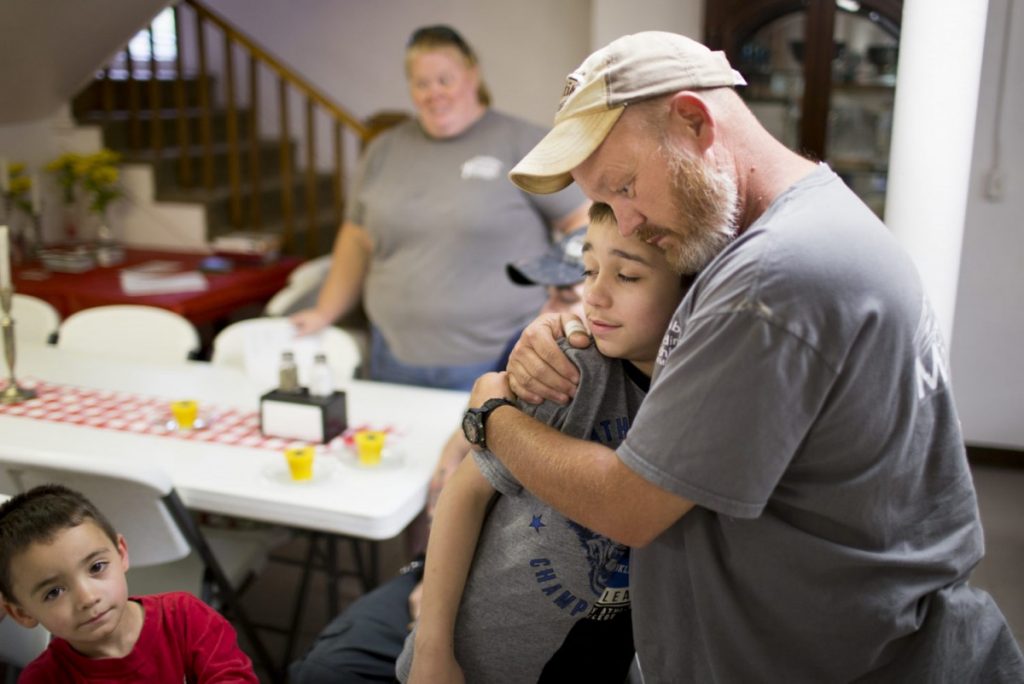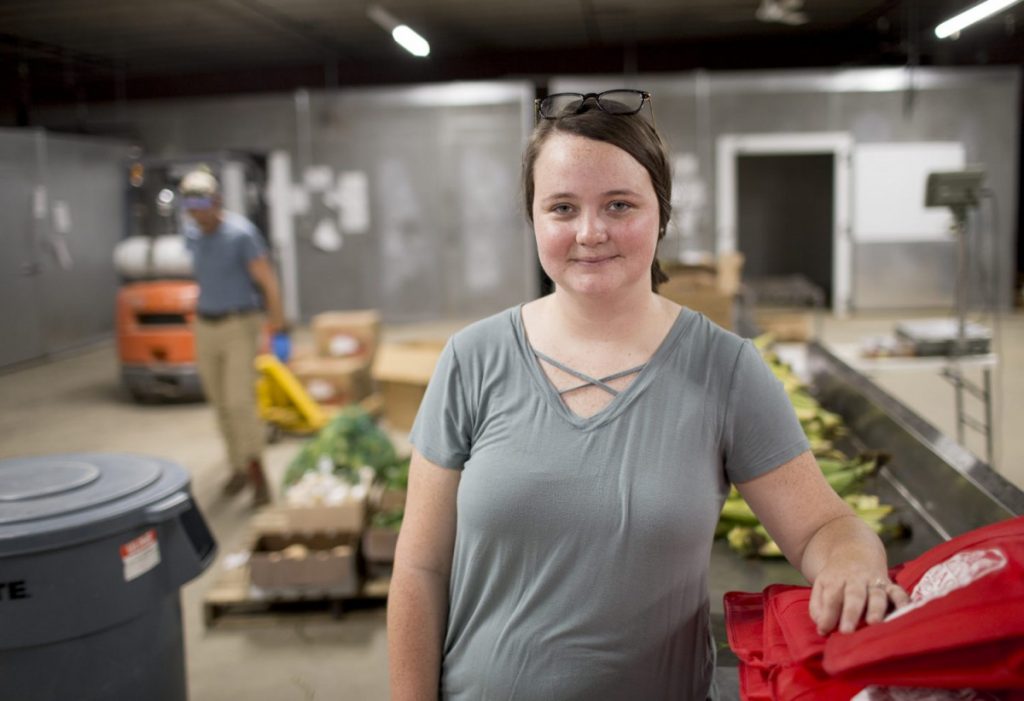Nonprofit groups seek creative solutions to hunger despite obstacles of geography and infrastructure in Mitchell, Yancey and Avery counties.
Spruce Pine, a small town in Mitchell County, is among many rural communities in the mountains of North Carolina that face food insecurity and hunger, driven by isolation.
Allen and Amy Hoilman run the Neighbors Feeding Neighbors food bank in Spruce Pine, which also hosts a weekly community meal in Newdale, in eastern Yancey County. Allen said the entire area is difficult to get to from outside, and while plans have been made to create an easier access point, he is unsure if it will help.
“It didn’t used to be this way,” he said. “You would know all your neighbors. There were plenty of jobs. Things have changed around here. The drugs and alcohol are here. All the jobs are gone.”
In recent years, highway U.S. 19E through the region has been the object of a major widening project to improve outside access. But so much had already happened, he said: “That road came 30 years too late.”
In nearby Yancey and Avery counties — like Mitchell, rural mountain counties clustered between the region’s larger population centers in Asheville and Boone — isolation poses the same problem.
For 37 years, Reaching Avery Ministry has operated a thrift store and food bank in Avery County.
The organization’s current director, Janet Millsaps, said the isolation of Avery County prevents good jobs from coming to the area.
“We’re not accessible by any major interstates,” Millsaps said. “We are kind of isolated, and so when you’re looking at big industries wanting to come, this is not a typical place that they would look at because of the transport on and off the mountain, what that looks like and what that would cost.”

No industry, no jobs
The biggest industry in Avery County is Christmas tree farming. Most families who come to Reaching Avery Ministry for help have at least one family member working on the farms.
During the winter, the people work on Christmas tree farms helping get the trees to consumers. In the summer, they often work as landscapers on the farm to prepare for the winter seasons.
Although the tree farms provide income for half a year at most, it is not steady and it does not come with benefits.
Millsaps said this is part of Avery County’s problem.
“It doesn’t take but one thing. A car repair, a doctor visit, a sickness, for families to come in a crisis,” Millsaps said. “We have a lot of working poor families. They work, but they don’t have insurance, they don’t have benefits, so when they’re out of work, then that becomes a big issue, and food insecurity is a big part of that.”
Allen Hoilman said Mitchell County faces a similar problem. There was once a tire factory where innovations in the industry were made, but it is now a skeleton of a building with abandoned tires in the yard.
With no industry, seasonal or otherwise, Mitchell County residents are left with little choice other than to leave the area to find work.
Hoilman said this introduces a new set of problems.
“It’s hard to get a job because they can’t afford to get to work,” he said.

Fighting hunger with local farmers
A Yancey County organization is taking a non-traditional approach to combating food insecurity, one that brings the community together.
Toe River Aggregation Center Training Organization Regional Food and Farms — better known as TRACTOR Food and Farms — helps farmers get their food to the people who need it most.
“TRACTOR is all about helping small farmers in the community sell and market their produce into the hand of people in the community that need it,” Becca Smith, TRACTOR’s sales manager said.
Since starting, TRACTOR has donated more than 10 tons of food to local food banks.
Located in an old sock factory, TRACTOR is open 24 hours a day for farmers to drop off food. While there, they can sort their produce into one of five industrial coolers that are all kept at different temperatures to keep a variety of foods fresh. They may also use a machine that washes and sorts produce.
TRACTOR operates on a CSA, or community-supported agriculture, model. Instead of a traditional CSA, where a community pays upfront for a season’s worth of food from a single farmer, TRACTOR partners with 33 different farmers. TRACTOR members who pay at the beginning of the season are eligible to get a bag of food each week.
Last year, TRACTOR received funding to enact a second component to its CSA: a clinical referral program.
The referral program, modeled on a pilot in Asheville, required doctors to write a prescription for fresh food for someone in need. With that referral, recipients can come to TRACTOR to get a bag of food at no cost.
“It’s the exact same bag, so it’s super dignified,” Smith said. “You wouldn’t know who’s paying for it and who’s not when they come to pick it up.”
In its first year, 101 referrals came to TRACTOR from three different clinics. Combined with 60 paid memberships, the organization was able to give out an average of 120 bags each week for the 18-week season.
With a frost date of Oct. 15, the end of the season is quickly approaching.
Smith said she has been getting a lot of questions about where people who rely on TRACTOR for food can go during the winter, but there is no easy answer to that.
For the most part, other organizations that provide less healthy options with a longer shelf life are left to fill the gap.
During the off-months, TRACTOR works with farmers to plan for the next season so they can provide as much food to as many people as possible.
Jim Edwards is one of these farmers. He grew up on a dairy farm in the ’60s, saw his family farm transition into a tobacco farm and, for the past five years, a pepper farm. This year he planted 4 acres of sweet corn to go with his peppers.
Edwards helped start TRACTOR’s predecessor and has been working with TRACTOR since it started.
He said he tries to make a difference where he can, and TRACTOR allows him to do that.
“It’s a terrible thing to think about, having hungry people in a land that’s so bountiful with food,” Edwards said. “We shouldn’t have hungry people.”

How small-town food banks are helping
When money for food is hard to come by, many residents in this area are going to food banks like Neighbors Feeding Neighbors and Reaching Avery Ministry to make ends meet.
In Mitchell County, Neighbors Feeding Neighbors operates out of a stone house owned by a church. While the organization is not associated with this church — the directors belong to another — the church offered up its extra space.
Neighbors Feeding Neighbors was started by the Hoilmans only a few years ago. The couple said they prayed about whether or not to start the organization for two years. Because they had experienced food insecurity themselves and received help from their community when they needed it, they decided to start the organization to give back.
They started with only three families and asked Facebook friends for donations. After only a few days, their home was overflowing with food in response.
In the years since, the organization has grown exponentially. The Hoilmans moved into the stone house to have more space than their own home could provide, but they are quickly growing out of this location as well.
The house is packed floor to ceiling with food ready to be handed out. Shelves line the walls, and multiple refrigerators throughout the house are packed. Boxes are scattered on the floor, waiting to be sorted or delivered.
Most people serviced by Neighbors Feeding Neighbors are disabled or elderly and are unable to get to the pantry themselves, or they do not have the transportation necessary. Allen Hoilman, along with assistant director Josh Robinson and Jerry Sullens, who relies on Neighbors Feeding Neighbors himself, delivers food boxes to anyone who needs them, wherever they are.
“We work all day here,” Allen Hoilman said. “Everything you see has been touched by these hands. My wife is up at night filling out paperwork. Sometimes we don’t get in bed until midnight, only to wake up the next morning and do it all over again.”
Neighbors Feeding Neighbors needs more volunteers, but Amy Hoilman said the group is cautious about whom it selects. She said the organization doesn’t want volunteers to treat their families as if they are less than or talk negatively about them just because they are facing hard times.
Allen Hoilman said this is also something that concerns him because they see the poorest people in Mitchell County on a daily basis.
A situation that stands out to him is one in which someone was sleeping on an overturned picnic table on a mattress black with dirt to keep away from rats.
With no power or running water, they used the bathroom outside and stored what little food they did have in a cooler sitting in a creek.
With help from Neighbors Feeding Neighbors, they were able to get to a place with food storage and a suitable place to sleep.
Amy Hoilman said that if people are in a tough spot, Neighbors Feeding Neighbors tries not to turn anyone away, regardless of circumstances.
“That’s not what we’re about,” she said. “We don’t see religion, we don’t see race. We don’t care who you’re married to, man and man, woman and man, woman and woman. It don’t matter. If you come to us for help, we’ll help you.”
Reaching Avery Ministry operates on a slightly different model from a traditional food bank.
The front of the building holds a thrift store filled with donated items that are sold at a low cost to anyone in the community. The profits from the store cover the overhead needed to keep the organization running. What is left, along with all donations, goes into the food bank, which is in the back of the building.
To be eligible, recipients must complete an intake application consisting of name and address, who lives with them, if they work and where, and if they receive benefits. If they are receiving food stamps, they are automatically eligible to receive a box of food.
Millsaps said the organization does not have a baseline on who is eligible and who is not, instead operating on a case-by-case basis.
Those who are eligible can receive one box a month with enough food to last their household a week.
When recipients come in, they are greeted by an employee who gets their name and checks their file to make sure it is time for them to receive a box. While an employee prepares the box with meat and frozen and canned foods, recipients can go through boxes in the lobby. These boxes contain extra items like salad dressings, and vitamins can be selected to supplement their box.
Millsaps said many families come in once a month, but some only come once or twice when they are faced with hard times.
“They maybe don’t qualify for food stamps, but they’ve had some kind of traumatic experience, whether it be sickness or accident or some kind of loss of work, job or temporary loss of income that we would help them until they get back on their feet,” Millsaps said.
Small solutions to big problems
Millsaps said while she is grateful for the support the organization has, there is still no long-term solution to the systemic problem that is food insecurity.
Nonprofit organizations in the region can offer assistance to individuals in need, but defeating food insecurity will require economic growth. For Avery County, Millsaps said the only real solution is to bring in industry.
She said even a big-box retailer like Walmart would make a difference in the community by providing more people with stable jobs and benefits. But bringing in something like a Walmart poses more problems than just building in an isolated location.
Some Avery County residents would not want it, Millsaps recognizes. “I’m in the minority when I say I want a Walmart,” Millsaps said.
“They just want to stay with the smaller hometown businesses, and I try to support our small hometown business because I believe in them, I like them, but I think we need to grow to be able to survive.”
This article was originally published by Carolina Public Press. Carolina Public Press is an independent, in-depth and investigative nonprofit news service for North Carolina.
The Faces of Hunger project is a year-long reporting initiative from Carolina Public Press focusing on issues of food insecurity in rural North Carolina, including its impact, root causes and potential solutions. In addition to sharing the stories and experiences of people most impacted by hunger in the region, this in-depth project will include reporting on the issues and systems impacting hunger. Carolina Public Press will also offer opportunities for community dialogue and resource sharing.



